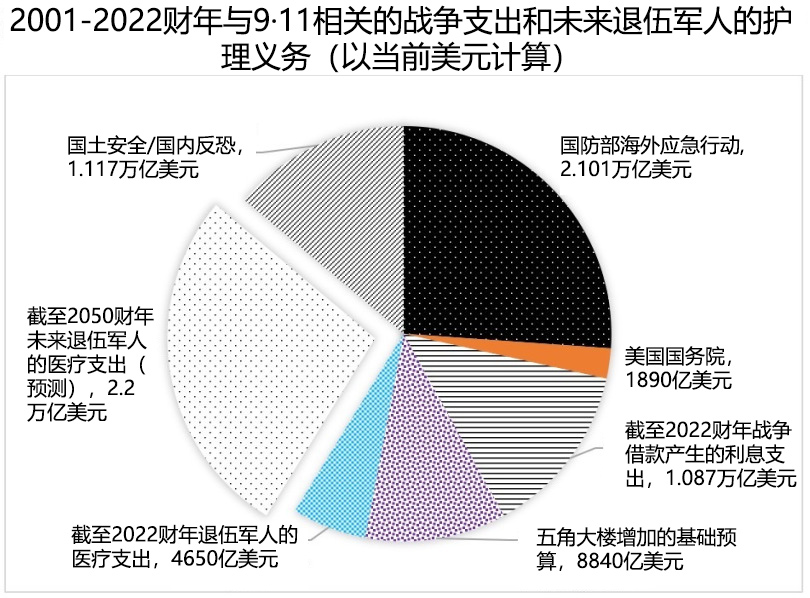阿富汗和伊拉克战争的成本,可能比你想象的高出数万亿
8月30日,当最后一架美国军用飞机于午夜到来前的一分钟从阿富汗的喀布尔机场起飞时,美国似乎关上了长达20年战争的大门。而此时距离2001年10月美军在那里投下第一批炸弹,已经过了整整7267天。“我们的外交将发挥带头作用。”为了纪念这一时刻,美国国务卿安东尼·布林肯在华盛顿发表讲话说,“军事任务已经结束。”
这也许是“结束”,也许并没有。战争过后,留下的是巨额的开支,其中大部分来自借款资助。阿富汗战争带来的财政影响可能会持续长达几十年。
在9月1日公布的两份报告中,经济学家和社会科学家分析了阿富汗和伊拉克战争,以及规模小得多的叙利亚和也门战争的成本。他们得出的结论是:最终成本超过8万亿美元,远高于此前的估计。他们计算,美国仅在阿富汗战争上就花费了2万亿美元——这一数字是美国总统乔·拜登于8月16日所说的两倍。当时,他为从阿富汗混乱的撤军辩护:“我们总共花了超过1万亿美元。”
从某一方面来看,拜登是正确的:这1万亿美元包括了五角大楼自2001年以来为阿富汗战争提供的所有军事拨款;但是,这个数字不包括美国为战争借款支付的利息,也不包括美国迄今为止向在阿富汗和伊拉克阵亡的7000多名美国士兵(其中2461名在阿富汗)的亲眷支付的约7.04亿美元的死亡抚恤金。这个数字是布朗大学(Brown University)的沃森研究所(Watson Institute)与波士顿大学(Boston University)的弗雷德里克·帕迪中心(Frederick S. Pardee Center)合作的“战争成本”(Costs of War)项目发布的《“9·11”事件之后美国战争预算成本》(The U.S. Budgetary Costs of the Post-9/11 Wars)报告中披露的几个数字之一。

战争支出中最昂贵的一项,远远超过了美国混乱的撤军所需要的时间——那就是为受伤退伍军人提供的医疗福利。报告估计,到2050年,这一福利支出总计将达到约2.3万亿美元。研究人员说,这项支出是过去20年战争造成的最不为人所知的经济负担之一。
“针对退伍军人的抚恤已经付出了多少钱,将来会付出多少钱——这是一直让我感到惊讶的事情。”报告作者、波士顿大学政治学教授、“战争成本”项目的联合主任内塔·C·克劳福德称。“这些老兵比以前的战争中病得更重,受伤的老兵也更多。”她说。这些费用包括对创伤后应激障碍和创伤性脑损伤的长期治疗,而这些疾病在20世纪70年代从越南战争撤回的退伍军人中从未得到诊断。大约5万名美国士兵在阿富汗和伊拉克受伤。
尽管金额眼花缭乱,但很少有美国人感受到了这几十年战争所带来的财政负担,尤其是在联邦税收下降、军事成本却在不断膨胀的情况下。阿富汗和伊拉克战争的几乎所有成本都来自借款,而其中大部分尚未偿还。
“很难想象我们谈论的未来会到什么程度。”克劳福德对《财富》杂志表示,“从百万到十亿再到万亿,看起来都是连续的数字后缀,但是每一个级别的增量,都意味着数字增加了1000倍。当你关注到我们将升级美国的所有基础设施时,你会发现其所需的一切支出都可以用1万亿美元来完成。”她说。
事实上,9月1日公布的另一份报告计算得出,如果美国没有发动阿富汗和伊拉克战争,国家可能会在哪些方面花费数万亿美元。总部位于华盛顿的美国政策研究所(Institute of Policy Studies)表示,用于军事战争的资金本来能够解决美国的许多问题,例如,用1.7万亿美元可以还清所有的学生债务,用4.5万亿美元让整个电网的碳排放清零,还能够向所有低收入国家提供新冠疫苗——最后这一项的费用甚至仅为250亿美元,仅仅略高于五角大楼2020年为阿富汗战争提供的最后一年预算——200亿美元。
“这确实是一个权衡问题。”美国政策研究所的报告《不安全状态:“9·11”事件以来军事化的代价》(State of Insecurity: the Cost of Militarization Since 9/11)的作者林赛·科什格里安认为。正如她对《财富》杂志所言:“我们在一件事情上花的钱越多,在其他事情上花的钱就越少。”
一些分析人士表示,这些权衡也扭曲了军事战略。他们认为,五角大楼对阿富汗和伊拉克的高度关注,牺牲了其处理过去20年里逐渐出现的其他冲突的可能性。
美国政策研究所的国家优先项目(National Priorities Project)的负责人科什格里安认为,如果把军费预算重新分配到医疗和教育领域,许多美国人会支持削减军事预算。但去年,两项分别削减10%预算的提案均未能够在美国国会通过。现在,关于是批准拜登提出的明年7150亿美元军费开支的请求,还是在阿富汗战争已经结束的情况下削减预算这一问题,政界人士存在严重分歧。
最终,美国人可能仍然不会感受到军事成本的存在,就像他们在过去20年没有感受到经济拮据的情况一样。随着最后一名美军撤出阿富汗,“数千亿美元”的概念似乎越来越抽象。
不过,科什格里安相信大多数人会支持削减军事开支,以支持医疗保健、教育和基础设施建设的发展。“美国民众想要的,和我们在华盛顿的代表给我们的之间存在很大的分歧。”她说,“当美国民众去投票时,国家安全和外交政策不是最重要的考虑因素。”(财富中文网)
编译:杨二一
8月30日,当最后一架美国军用飞机于午夜到来前的一分钟从阿富汗的喀布尔机场起飞时,美国似乎关上了长达20年战争的大门。而此时距离2001年10月美军在那里投下第一批炸弹,已经过了整整7267天。“我们的外交将发挥带头作用。”为了纪念这一时刻,美国国务卿安东尼·布林肯在华盛顿发表讲话说,“军事任务已经结束。”
这也许是“结束”,也许并没有。战争过后,留下的是巨额的开支,其中大部分来自借款资助。阿富汗战争带来的财政影响可能会持续长达几十年。
在9月1日公布的两份报告中,经济学家和社会科学家分析了阿富汗和伊拉克战争,以及规模小得多的叙利亚和也门战争的成本。他们得出的结论是:最终成本超过8万亿美元,远高于此前的估计。他们计算,美国仅在阿富汗战争上就花费了2万亿美元——这一数字是美国总统乔·拜登于8月16日所说的两倍。当时,他为从阿富汗混乱的撤军辩护:“我们总共花了超过1万亿美元。”
从某一方面来看,拜登是正确的:这1万亿美元包括了五角大楼自2001年以来为阿富汗战争提供的所有军事拨款;但是,这个数字不包括美国为战争借款支付的利息,也不包括美国迄今为止向在阿富汗和伊拉克阵亡的7000多名美国士兵(其中2461名在阿富汗)的亲眷支付的约7.04亿美元的死亡抚恤金。这个数字是布朗大学(Brown University)的沃森研究所(Watson Institute)与波士顿大学(Boston University)的弗雷德里克·帕迪中心(Frederick S. Pardee Center)合作的“战争成本”(Costs of War)项目发布的《“9·11”事件之后美国战争预算成本》(The U.S. Budgetary Costs of the Post-9/11 Wars)报告中披露的几个数字之一。
战争支出中最昂贵的一项,远远超过了美国混乱的撤军所需要的时间——那就是为受伤退伍军人提供的医疗福利。报告估计,到2050年,这一福利支出总计将达到约2.3万亿美元。研究人员说,这项支出是过去20年战争造成的最不为人所知的经济负担之一。
“针对退伍军人的抚恤已经付出了多少钱,将来会付出多少钱——这是一直让我感到惊讶的事情。”报告作者、波士顿大学政治学教授、“战争成本”项目的联合主任内塔·C·克劳福德称。“这些老兵比以前的战争中病得更重,受伤的老兵也更多。”她说。这些费用包括对创伤后应激障碍和创伤性脑损伤的长期治疗,而这些疾病在20世纪70年代从越南战争撤回的退伍军人中从未得到诊断。大约5万名美国士兵在阿富汗和伊拉克受伤。
尽管金额眼花缭乱,但很少有美国人感受到了这几十年战争所带来的财政负担,尤其是在联邦税收下降、军事成本却在不断膨胀的情况下。阿富汗和伊拉克战争的几乎所有成本都来自借款,而其中大部分尚未偿还。
“很难想象我们谈论的未来会到什么程度。”克劳福德对《财富》杂志表示,“从百万到十亿再到万亿,看起来都是连续的数字后缀,但是每一个级别的增量,都意味着数字增加了1000倍。当你关注到我们将升级美国的所有基础设施时,你会发现其所需的一切支出都可以用1万亿美元来完成。”她说。
事实上,9月1日公布的另一份报告计算得出,如果美国没有发动阿富汗和伊拉克战争,国家可能会在哪些方面花费数万亿美元。总部位于华盛顿的美国政策研究所(Institute of Policy Studies)表示,用于军事战争的资金本来能够解决美国的许多问题,例如,用1.7万亿美元可以还清所有的学生债务,用4.5万亿美元让整个电网的碳排放清零,还能够向所有低收入国家提供新冠疫苗——最后这一项的费用甚至仅为250亿美元,仅仅略高于五角大楼2020年为阿富汗战争提供的最后一年预算——200亿美元。
“这确实是一个权衡问题。”美国政策研究所的报告《不安全状态:“9·11”事件以来军事化的代价》(State of Insecurity: the Cost of Militarization Since 9/11)的作者林赛·科什格里安认为。正如她对《财富》杂志所言:“我们在一件事情上花的钱越多,在其他事情上花的钱就越少。”
一些分析人士表示,这些权衡也扭曲了军事战略。他们认为,五角大楼对阿富汗和伊拉克的高度关注,牺牲了其处理过去20年里逐渐出现的其他冲突的可能性。
美国政策研究所的国家优先项目(National Priorities Project)的负责人科什格里安认为,如果把军费预算重新分配到医疗和教育领域,许多美国人会支持削减军事预算。但去年,两项分别削减10%预算的提案均未能够在美国国会通过。现在,关于是批准拜登提出的明年7150亿美元军费开支的请求,还是在阿富汗战争已经结束的情况下削减预算这一问题,政界人士存在严重分歧。
最终,美国人可能仍然不会感受到军事成本的存在,就像他们在过去20年没有感受到经济拮据的情况一样。随着最后一名美军撤出阿富汗,“数千亿美元”的概念似乎越来越抽象。
不过,科什格里安相信大多数人会支持削减军事开支,以支持医疗保健、教育和基础设施建设的发展。“美国民众想要的,和我们在华盛顿的代表给我们的之间存在很大的分歧。”她说,“当美国民众去投票时,国家安全和外交政策不是最重要的考虑因素。”(财富中文网)
编译:杨二一
When the last U.S. military aircraft lifted off from Kabul Airport a minute before midnight in Afghanistan on August 30—7,267 days after dropping the first bombs there in October 2001—America seemingly shut the door on the 20-year war, and moved on. “We will lead with our diplomacy,” Secretary of State Antony Blinken said in a speech in Washington, to mark the moment. “The military mission is over.”
“Over,” perhaps—though not wrapped up. Left behind is the war’s mammoth expense, the bulk of it financed with borrowed money and whose financial impact could be felt for decades.
In two reports out on September 1, economists and social scientists unpacking the costs of the Afghanistan and Iraq wars, and far smaller engagements in Syria and Yemen, put the final tab at more than $8 trillion, well above previous estimates. About $2 trillion, they calculate, was spent on the Afghanistan war alone—double what President Joe Biden stated on Aug. 16, when he defended the tumultuous withdrawal from Afghanistan, in part by saying, “We spent over a trillion dollars.”
Biden was correct in one respect: The trillion-dollar sum comprises all military appropriations by the Pentagon for the Afghanistan war since 2001. But the figure did not include the interest payments on money the U.S. borrowed to fight the war. Nor did it include death benefits of about $704 million paid so far to the survivors of more than 7,000 U.S. soldiers killed in Afghanistan and Iraq, about 2,461 of them in Afghanistan. That figure is among several revealed in one of the new reports, The U.S. Budgetary Costs of the Post-9/11 Wars, published by the Costs of War project at Brown University’s Watson Institute and Boston University’s Frederick S. Pardee Center.
But the biggest-ticket item of all will far outlast the chaotic U.S. withdrawal: The medical benefits for wounded veterans, which the report estimates could reach about $2.3 trillion by 2050. That figure, say the researchers, is among the least-known financial burdens from the past two decades of war.
“What has consistently surprised me is how much veterans’ care has cost and will cost,” said the author of the report Neta C. Crawford, political science professor at Boston University and codirector of the Costs of War project. “These vets are sicker, and more injured, than in previous wars,” she said. The costs include long-term treatment for post-traumatic stress disorders and traumatic brain injuries—conditions that went undiagnosed among the vets who returned home from the Vietnam War in the 1970s. About 50,000 U.S. soldiers were wounded in Afghanistan and Iraq.
Despite the dizzying sums, few Americans have felt the financial burden from decades of war, especially since their federal taxes have gone down even while military costs have ballooned. Almost the entire cost of the Afghan and Iraq wars has come from borrowed money, much of which has yet to be repaid.
“It is difficult to image the scale of what we are talking about into the future,” Crawford told Fortune. “Million, billion, trillion—it all rhymes, but you’re looking at 1,000 times more with each increment,” she says. “When you look at how we’ll upgrade all the infrastructure in the U.S., it could all be done with a trillion dollars.”
Indeed, a second report, also out on September 1, calculates what the U.S. might have spent those trillions on, had it not launched wars in Afghanistan and Iraq. The Washington-based Institute of Policy Studies, or IPS, says the money spent on military combat could have solved multiple problems in the U.S., like erasing all student debt for $1.7 trillion, decarbonizing the entire electricity grid for $4.5 trillion, or providing COVID-19 vaccines to all low-income countries for just $25 billion—only slightly higher than the $20 billion the Pentagon budgeted in 2020 for the final year of the Afghan War.
“It really does come down to tradeoffs,” said Lindsay Koshgarian, who wrote the institute’s report, State of Insecurity: The Cost of Militarization Since 9/11. As she told Fortune, “The more we are spending on one thing, the less we are spending on other things.”
Those tradeoffs have also skewed military strategy, according to some analysts, who argue that the Pentagon’s intense focus on Afghanistan and Iraq has come at the expense of dealing with other conflicts that steadily emerged during the past 20 years.
Koshgarian, who heads the National Priorities Project at IPS, believes many Americans would support cuts in the military budget if the money was reallocated to health care and education. But last year two separate proposals for a 10% cut failed to pass in Congress. Now politicians are bitterly divided over whether to approve Biden’s request for $715 billion in military spending for the coming year or whether to cut the budget, now that the Afghan War has ended.
In the end Americans might not feel the military cost—just as they did not feel the pinch during the past 20 years. With the last U.S. soldier out of Afghanistan, the hundreds of billions could seem increasingly abstract.
Still, Koshgarian believes most would support cutting military spending in order to boost health care, education, and infrastructure. “There is a big divide between what Americans want and what our representatives in Washington are giving us,” she said. “National security and foreign policy are not top of the list when Americans go vote.”













